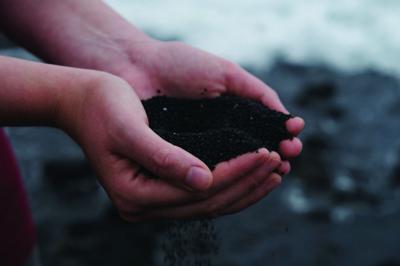More than 25 years ago I wrote Compost This Book!, a light-hearted but informative account of the world of deliberate decay. When I decided to write a column on this subject, however, I updated by getting in touch with Rick Carr, Farming Director and master composter at the Rodale Institute in Kutztown, Pennsylvania. Amid his other duties, Rick turns wastes from the Institute’s 333-acre farm into five to ten thousand pounds of finished compost a year. He also pursues a program of research into new ways to apply this material to healing the soil and growing plants.
My first question to Rick was how he would define composting. His response was succinct: “managed aerobic decomposition.” Decomposition, of course, will happen without human interference — I have a hat on which is embroidered the motto “Compost Happens” — but management of the process can greatly accelerate it and also keep it from taking a bad turn.
The “aerobic” aspect of composting is critical. The type of decomposition you want to pursue takes place in the presence of oxygen; that is what produces a stable organic material that is a nearly ideal enhancement to plant growth. When deprived of oxygen, a different class of decomposers take over that produce foul odors.
The use of the word organic in the preceding paragraph is significant, because this type of decomposition involves only organic materials. The definition of “organic” is, in this case, important. Organic gardeners use this word to signify any material of a natural origin, including such things as granite dust and powdered sulfur. The definition of organic that applies to your compost heap, though, is taken from chemists. To them, an organic compound is any material that contains carbon or its derivatives in a carbon chain or carbon ring form. The chemists’ type of organic compounds include many man-made substances as well as those of natural origin. As a result, potential compostables actually include some things you might not expect. When I was researching Compost This Book!, for instance, I spoke to a composting consultant who had helped the U.S. Army remediate some soil at a weapons depot polluted with TNT—Trinitrotoluene. By mixing wastes from a local vegetable processing plant and manure from a nearby buffalo ranch with the soil, the consultant was able to cause it to heat up and break down the TNT, reducing it by 97 percent. The only catch was that the initial input of TNT had to remain below 12 percent or the process could spin out of control and the compost heap would detonate.
The backyard compost heap, however, should be fed a less exotic diet. Yard trimmings, grass clippings and kitchen wastes are all fair game, although the home composter should avoid adding meat and dairy products, as those tend to attract scavengers to the heap. Rick has reduced the formula to the acronym WONC: water, oxygen, nitrogen, and carbon.
Moisture is essential for the microorganisms that perform the bulk of the decomposition, but add too much water to the heap and it will soak the materials, driving out the air which is also needed to supply oxygen. Nitrogen and carbon describe the materials on which the decomposers feed. Nitrogen is furnished, typically, by “green and juicy” materials such as grass clippings or vegetable peelings; carbon by “brown and dry” materials such as fall leaves. Generally, Rick says, he adds three to five buckets of brown and dry materials to the heap for each bucket of green and juicy.
Get the proportions of these materials right, and amass enough to make a heap of a cubic yard or so and it will quickly heat up, reaching internal temperatures of as much as 150°F. When it begins to cool, turning the materials with a garden fork can encourage it to heat up again. A heap that never heats up will still decompose, but more slowly. A heap that really cooks (and I do mean cook; I once slow cooked a chicken in my compost heap, although I don’t recommend this) can reduce itself to finished compost, a black crumbly material, in as little as six weeks. A heap that never heats up may take a year or two to accomplish the same task.
The virtues of finished compost as a soil additive, I will detail in a future column. Or you can listen to the rest of my conversation with Rick Carr on Berkshire Botanical Garden’s Growing Greener podcast, by logging onto thomaschristophergardens.com.
Be-a-Better-Gardener is a community service of Berkshire Botanical Garden, located in Stockbridge, Mass. Its mission, to provide knowledge of gardening and the environment through a diverse range of classes and programs, informs and inspires thousands of students and visitors each year. Thomas Christopher is a volunteer at Berkshire Botanical Garden and is the author or co-author of more than a dozen books.









